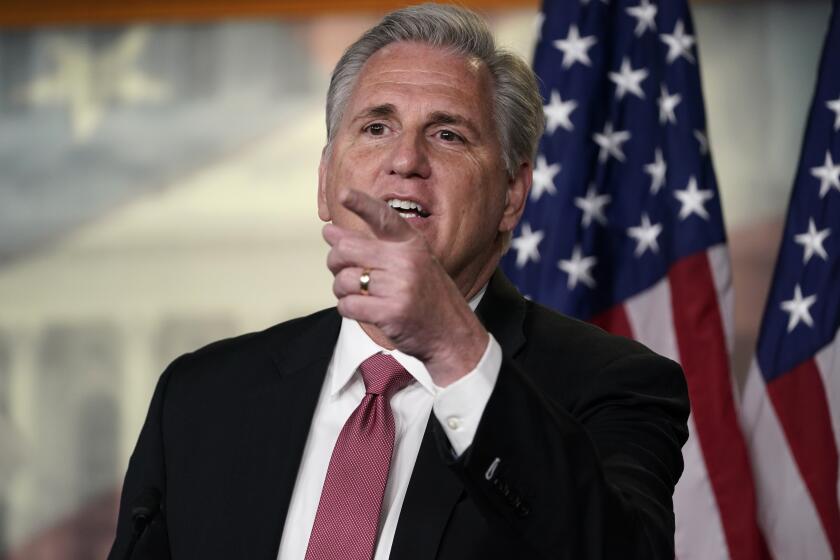Column: Mike Pence, would-be president, has a plan to kill Social Security. It will cost you

Former Vice President Mike Pence dipped his toes into the presidential campaign waters Feb. 2 with a proposal that would mean the death of Social Security.
Pence made his remarks on stage during a conference of the National Assn. of Wholesaler-Distributors in Washington. The event wasn’t open to the public, but a video and transcript was posted by American Bridge, which is affiliated with the Democratic Party.
That’s when Pence unearthed the old Republican idea of privatizing Social Security wholly or partially.
We can replace the New Deal with a better deal.
— Former Vice President Mike Pence, airing out a never-fulfilled GOP promise
“Give younger Americans the ability to take a portion of their Social Security withholdings and put that into a private savings account,” he proposed. “A very simple fund that could generate 2% would give the average American twice what they’re going to get back on their Social Security today.”
Pence didn’t say outright that he advocates killing Social Security. Instead, he took the course I reported on just last week. That’s the Republican and conservative habit of employing plausible-sounding jargon and economists’ gibberish to conceal their intention to hobble the program.
Get the latest from Michael Hiltzik
Commentary on economics and more from a Pulitzer Prize winner.
You may occasionally receive promotional content from the Los Angeles Times.
But make no mistake: Diverting any significant portion of Social Security taxes into private accounts would make the program unworkable, funnel untold wealth into the hands of Wall Street promoters and leave millions of families destitute.
It’s amazing that Pence would air out the private-account idea now, after a year in which the stock market returned a negative 23% (inflation-adjusted, as measured by the Standard & Poor’s 500 index).
It was just such a dose of reality that helped kill the same proposal when it was put forth by President George W. Bush in 2001; Bush abandoned the idea in 2005, after the stock market return for 2001 to 2005 came to negative 2%, including two years of double-digit losses.
I wrote a book at that time explaining that the Bush plan was “endangering our financial future.” That’s still true of private accounts.
Pence has long been a cheerleader for private accounts, which isn’t the same as saying that he has given the topic the thought it deserves.
Raising the Social Security retirement age would hurt low-income and Black workers. Is that why Republicans love it?
In his Feb. 2 appearance, Pence attacked Social Security by employing the bog-standard GOP rhetoric about fiscal policy and “entitlements.”
He whined about “this trajectory of massive debt that we’re piling on the backs of [our] grandchildren” and attributed most of it to Social Security and Medicare (the “entitlements”). Never mind that well more than $1 trillion of that debt was incurred when his party passed a massive tax cut for the rich in 2017.
He promised, as Social Security “reformers” always do, that he would hold seniors harmless: “To everyone that’s got hair the same color hair as me, nothing’s going to change for you,” but younger Americans would face a changed landscape, “better choices that would also be better for the country.”
This is also a cherished Republican stunt — guaranteeing that their “reforms” won’t harm current retirees and the near-retired. It’s pure politics because they know that seniors would slaughter them at the polls otherwise. But if their ideas are so great, one must ask, why not impose them on everybody?
Pence claimed that “we can replace the New Deal with a better deal.”
Never mind that the GOP has never proposed any deal better for ordinary Americans than the New Deal — the Rooseveltian program that brought us Social Security, the National Labor Relations Act, more effective regulation of the financial markets and work-relief programs that kept millions of families out of poverty during the Great Depression.
The New Deal remade the relationship between the U.S. government and its citizens so that, for the first time, government served the average citizen, not merely the rich. Ever since the New Deal’s historic launch in 1933, Republicans have tried to turn the clock back to prehistoric times.
So here comes Mike Pence. It’s unclear from the video and transcript posted by American Bridge whether he thought much about what he was saying before his words came out of his mouth, but the gist of his presentation is suitably horrifying.
The allure of private accounts is based on the assumption that average Americans can accumulate more wealth by investing all or part of their Social Security contributions on their own.
The omnibus bill signed by President Biden will make it easier for many people to save for retirement, but more help is needed
The promise is that they would exceed the wealth implicit in their Social Security retirement benefits by harnessing what conservative economist Milton Friedman called “the power of the market” (he meant the stock market) over the average 45-year working life of American workers.
Promoters of private accounts during the George W. Bush years promised that private accounts would produce million-dollar nest eggs for typical Americans: “This isn’t a lottery jackpot,” gushed Sam Beard, a member of the 2001 Social Security commission established by Bush to make the case for private accounts. “Whoever earns at least the minimum wage can become a millionaire in 45 years.”
This claim was always dependent on ignoring the multitude of pitfalls along the way. Let’s examine them.
To begin with, it was based on investors collecting the long-term annual return of 8% from stock market investments, even after inflation. Seen from one perspective, that projection seems conservative. Over the last 100 years, after all, the stock market as measured by the Standard & Poor’s 500 index has returned an average 9.43% a year after inflation.
But that’s misleading to the point of being an outright lie.
Think of it this way: Let’s say you start with $1,000, and this year you gain 100%. Now you have $2,000. But next year your portfolio falls by 50%; your “average” return over the two years has been 25%. But you’re back to where you started, with $1,000, so your real gain is zero. That’s your compound annual growth rate, or CAGR, and it’s the only calculation that incorporates the rise and fall of volatile investments such as stocks.
The inflation-adjusted CAGR of the S&P 500 over the last century is 7.51%. That’s the benchmark we must use for private accounts. Investment returns over successive 45-year stretches, however, are highly variable. In just the last 15 years, from 2007 through the end of 2022, the CAGR of 45-year investment periods has ranged from 4.57% (for the 1964-2008 period) to 8.27% (for the 1975-2019 period).
Over a lifetime of investing, that produces a vast divergence in retirement nest eggs. Those who were sufficiently lucky, or wise, to retire in 2017 after investing, say, $1,000 a year in their personal accounts for 45 years straight would have about $419,785. Those who retired in 2008 after investing the same $1,000 annually for 45 years would have only $141,575, or about one-third as much.
Despite being humbled at the polls, Mitt Romney and other Republicans are still advocating cuts in Social Security. Congressional Democrats should take away their leverage.
Even a single year might make a huge difference. Those who retired in 2016 would end up with about $256,732 after their 45-year block; those who started and ended their careers only one year later would have nearly 40% more.
This could create a political problem. Politicians would face pressure to bail out the most unfortunate cohorts — but any such proposals might be resisted from the most fortunate retirees.
Another problem that private account promoters gloss over is that stock market volatility undermines the predictability of retirement resources. A 20% one-year decline in the S&P 500 wouldn’t be much of a problem for workers who had just launched their portfolios — at the end of that year they’d have $800, but 44 years to make up the loss.
But suppose the crash came in year 45. Last year’s stock market decline would pare a worker’s $400,000 nest egg by about $80,000. That might be a big enough loss to prompt would-be retirees to keep working or abandon their dreams of a retirement home or an around-the-world cruise. (That’s exactly what happened last year to many real-world retirees with savings tied up in stock.)
Now consider the handover of worker assets to Wall Street under a private account program. Pence complacently assured his audience that “the government would oversee” private accounts, but what does that mean?
Certainly not that the government would manage those accounts; that would be an enormous task, given tens of millions of individual accounts. Instead, workers might be prompted to entrust their accounts to financial services firms, which would exact fees in one form or another — and not always fully disclosed.
Just last year, the Securities and Exchange Commission fined Charles Schwab & Co. $187 million for hiding fees and expenses from clients invested in mutual funds that were advertised as having neither advisory nor hidden fees.
Fees and expenses can devastate an investment portfolio. As the SEC advises investors, even a 1% annual fee can shave $30,000 from a $100,000 investment over 20 years, compared with a 0.25% fee. Fees aren’t relevant to Social Security, which bases its retirement benefits on a worker’s pay over his or her best-earning 35 years.
Republican leaders are threatening to take the debt limit hostage unless they get Social Security and Medicare benefit cuts.
The most deceptive aspect of the push for private accounts is that it ignores several key features of Social Security. One is that the program provides not only retirement benefits, but insurance for a family against a worker’s disability or untimely death. The other is that benefits are inflation-protected and guaranteed for life.
Private accounts can’t possibly replicate those features. As anyone would know who has tried to price a long-term annuity, inflation protection is incredibly expensive, especially during high-inflation periods like now; one must give up a sizable portion of present-day payments to have them keep up with the inflation rate into the future.
As for survivors and dependents, Social Security provides benefits for those whose breadwinner has died after qualifying for benefits, which happens after working for 10 years, or 40 quarters, in which he or she has earned at least $1,650 in covered wages per quarter. After that point, widows or widowers are entitled to at least 71.5% of the deceased worker’s benefit, and every child up to the age of 18 (19 if in school) is entitled to 75% of the benefit.
A private account could provide that succor only up to the balance in the account. Typically, that would grow slowly in its first years and more rapidly as time goes on. A $1,000 annual contribution would grow to only about $18,800 after 10 years, even in the high-return stock markets of 2009-2021 when the inflation-adjusted CAGR was 13.54%. After 20 years of the same return, the portfolio would still be worth less than $86,000. Try making that stretch over a lifetime.
It’s true that Pence advocated “simple” accounts yielding 2% a year that he said “would give the average American twice what they’re going to get back on their Social Security today.” That’s highly unlikely.
As Eugene Steuerle of the Urban Institute calculated in 2021, someone retiring in 2025 and paying the maximum tax every working year will have paid $831,000 in Social Security taxes, including the portion paid by employers, over 45 years. That worker will collect, on average, $933,000 in lifetime benefits.
Even having paid the 2023 maximum of $19,864 (including both employee and employer shares) for the previous 45 years and earning 2% a year, that worker would have about $1.4 million upon retirement. That’s not twice his or her benefits, and in any case doesn’t cover the risks of early demise or disability, the guaranteed benefits over a long life, or inflation coverage.
It’s a crap shoot. And in craps, like any other gamble promoted as a sure thing, it’s the house that wins. Pence is carrying water for the Wall Street firms that will be circling small investors to suck up their assets. When they’re done, there will be nothing left of Social Security.
That’s Pence’s goal. When he smugly assures you that you can’t lose, check your wallet.
More to Read
Get the latest from Michael Hiltzik
Commentary on economics and more from a Pulitzer Prize winner.
You may occasionally receive promotional content from the Los Angeles Times.















